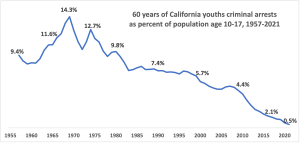The terrifying plunge in youth crime
By Mike Males | February 2023
Why aren’t mammoth revolutions in youth behavior that make today’s teenagers a uniquely low-crime population that reduced gun deaths dramatically headlined in the news and studied excitedly in institutional forums?
Crime, gun killings, and arrest rates by youths have fallen faster in California than in any other state over the last three to five decades, a trend that apparently horrifies authorities and the news media across the political spectrum.
As California’s youth population age 10-17 grew and became more racially diverse (73% now are of Color), rates of criminal arrest plunged by 92% since 1995, and 96% since 1975. Teenagers under age 20 are now much less likely to be arrested than Californians ages 50-59, a stunning development that overturns decades of assumptions about crime and depresses major interests so much they won’t even talk about it. (One exception: the San Francisco Chronicle’s excellent “Vanishing Violence” series.)
Around 8% of the youthful arrest decline is attributable to the decriminalization of marijuana in 2010, which reduced arrests for all ages. The COVID pandemic’s shutdown policies may have reduced crime in 2020, but youth arrests continued falling during the return to normalcy in 2021.
But the vast bulk of the decline is due to young people themselves. Violent crime rates among youth are down 75% over the last three decades, homicide arrests have fallen by 85%, and gun killings among youth have fallen by 72% — despite 1990s predictions of coming “hordes” of dark-skinned “adolescent super-predators” and scary recent headlines of a nonexistent youth crime “surge.” The crime plunge has saved the state over $10 billion in juvenile incarceration costs alone since 1995, with eight of 11 juvenile facilities closed already and the Division of Juvenile Justice slated to close altogether in July 2023.
California’s 35 Democratic-voting counties show larger declines in crime by youth, but both are down more than 90% since the early 1990s. Since the early 1990s, youth arrest trends have fallen by 90% in San Francisco, 90% in Siskiyou, 91% in Orange County, 92% in Los Angeles, 92% in Sacramento, 94% in San Diego, 94% in Santa Clara County (San Jose), 94% in Alameda County (Oakland), 95% in Fresno, 96% in Sierra County, and 99% in remote Mono County. California’s large urban counties had declines of 80% to 90% in violent crime rates among youth. In the early 1990s, California’s major counties suffered 500-600 firearms homicides among teenagers per year; in 2020-21, in a youth population 600,000 larger, around 150 per year – a rate decline of 80% to the lowest rate in at least 50 years.
The silence indicates a bad faith in institutional America, not only in protecting the profits of youth-crime industries from law enforcement to juvenile justice, treatment facilities, and prisons to sensationalist media, but an ego-flattering psychology that insists that adolescents are reckless and adults wise and mature. It’s time to abandon the 19th century myths that have governed crime discussion and move into the amazing opportunities the 21st century youth revolution offers.

